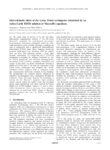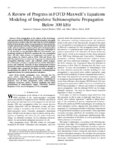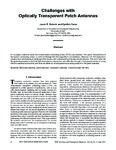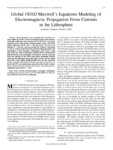1 - 25 of 23
| Creator | Title | Description | Subject | Date | ||
|---|---|---|---|---|---|---|
| 1 |
 |
Stringfellow, Gerald B. | Radiative pair transitions in p-type ZnSe:Cu crystals | Shallow levels with an ionization energy of 0.012 eV play an important role in the photoelectronic properties of p-type ZnSe:Cu crystals. These levels exhibit the characteristics of the higher-lying member of an imperfection pair involved in luminescence emission, as well as of a trap determining lo... | Ionization energy; Luminescence emission; Crystals | 1968 |
| 2 |
 |
Furse, Cynthia M. | A study on the efficiency of transparent patch antennas designed from conductive oxide films | Abstract? A study on the efficiency of transparent patch antennas designed from indium tin oxide (ITO) films is presented to provide design guidelines for patch type transparent antennas. The trade-offs between optical transparency and antenna efficiency is analyzed by considering typical materia... | 2011 | |
| 3 |
 |
Furse, Cynthia M. | A comparative study on two types of transparent patch antennas | Properties of optically transparent patch antennas designed from meshed conductor and transparent conductive films are studied and compared. It is shown that at S band, meshed antenna provides the best antenna efficiency for the highest transparency. It is practical to design a 90% transparent mesh... | 2011 | |
| 4 |
 |
Furse, Cynthia M.; Gandhi, Om P. | Why the DFT is faster than the FFT for FDTD time-to-frequency domain conversions | Although it is a time-domain method, the finite difference time-domain (FDTD) method has been used extensively for calculating frequency domain parameters such as specific absorption rate, radar cross-section, and S-parameters. When a broad frequency band is of interest, using a broad-band pulsed ... | Discrete Fourier transform; DFT; Fast Fourier transform; FFT; Finite-difference time-domain; FDTD; Frequency domain parameters | 1995-10 |
| 5 |
 |
Stringfellow, Gerald B. | Miscibility gaps and spinodal decomposition in III/V quaternary alloys of the type AxByC1−x−yD | Thermodynamic concepts have been developed for the calculation of solid-phase miscibility gaps and spinodal decomposition in quaternary alloys of the type AxByC1−x−yD. These concepts have been applied to the analysis of III/V quaternary alloys using the delta-lattice-parameter (DLP) solution mod... | Thermodynamics; Quartenary alloys; Coherent decomposition | 1983-01 |
| 6 |
 |
Tasdizen, Tolga | Using sequential context for image analysis | This paper proposes the sequential context inference (SCI) algorithm for Markov random field (MRF) image analysis. This algorithm is designed primarily for fast inference on an MRF model, but its application requires also a specific modeling architecture. The architecture is composed of a sequence ... | 2010 | |
| 7 |
 |
Stevens, Kenneth | Energy and performance models for clocked and asynchronous communication | Parameterized first-order models for throughput, energy, and bandwidth are presented in this paper. Models are developed for many common pipeline methodologies, including clocked flopped, clocked time-borrowing latch protocols, asynchronous two-cycle, four-cycle, delay-insensitive, and source synch... | 2003 | |
| 8 |
 |
Simpson, Jamesina J. | Electrokinetic effect of the loma prieta earthquake calculated by an entire-earth FDTD solution of Maxwell's equations | We report what we believe to be the first three-dimensional computational solution of the full-vector Maxwell's equations for hypothesized pre-seismic electromagnetic phenomena propagated within the entire Earth-ionosphere cavity. Periodic boundary conditions are used in conjunction with a variable-... | 2005-01-01 | |
| 9 |
 |
Simpson, Jamesina J. | A review of progress in FDTD Maxwell's equations modeling of impulsive subionospheric propagation below 300 kHz | Wave propagation at the bottom of the electromagnetic spectrum (below300 kHz) in the Earth-ionosphere waveguide system has been an interesting and important area of investigation for the last four decades. Such wave propagation is characterized by complex phenomena involving nonhomogeneous and aniso... | 2007-01-01 | |
| 10 |
 |
Furse, Cynthia M. | Challenges with optically transparent patch antennas | In this paper, antennas made out of transparent conducting oxides (TCOs) are explored. The optical transparency of transparent conducting oxides is achieved through thin-film depositions on substrates. However, thin-film depositions create a new set of electrical challenges that require a full under... | 2012-01-01 | |
| 11 |
 |
Furse, Cynthia M. | Take a Stand: Speaking about RF Safety | Tell your students at the beginning of the semester that they need to prepare a speech and deliver it before an off-campus audience, and they will not exactly be leaping out of their seats with joy. Remind them a week in advance that their speech is coming up, and you will inevitably have a student ... | Radio frequency safety; RF safety | 2004-12 |
| 12 |
 |
Furse, Cynthia M. | Take a stand: speaking about RF safety | Tell your students at the beginning of the semester that they need to prepare a speech and deliver it before an off-campus audience, and they will not exactly be leaping out of their seats with joy. Remind them a week in advance that their speech is coming up, and you will inevitably have a student ... | 2004-12 | |
| 13 |
 |
Furse, Cynthia M.; Gandhi, Om P. | Use of the frequency-dependent finite-difference time-domain method for induced current and SAR calculations for a heterogeneous model of the human body | This paper describes the use of the previously for mutated Frequency-Dependent Finite-Difference Time-Domain ((FD)2TD) method for analysis of an anatomically based heterogeneous man model exposed to ultra-wide-band electromagnetic pulse sources. The human tissues' electrical permittivities, ε*(ω),... | Finite-difference time-domain; FDTD; Ultrawideband electromagnetic pulses; Induced currents; Mass-normalized; Energy distribution; Specific absorption rates; SAR | 1994-01-01 |
| 14 |
 |
Stevens, Kenneth | Dynamic gates with hysteresis and configurable noise tolerance | Dynamic logic can provide significant performance and power benefit compared to implementations using static gates. Unfortunately dynamic gates have traditionally suffered from low noise margins, which limits their reliability. A new logic family, called complementary dynamic logic (CDL), is prese... | 2007 | |
| 15 |
 |
Simpson, Jamesina J. | Global FDTD maxwell's equations modeling of elctromagnetic propagation from currents in the lithosphere | Electromagnetic wave propagation from electric currents within the Earth's crust is investigated using a three-dimensional finite-difference time-domain (FDTD) full-vector Maxwell's equations model of the global Earth-ionosphere cavity. The FDTD model employed extends from -100 km below sea level to... | 2008-01-01 | |
| 16 |
 |
Harrison, Reid R. | Silicon implementation of the fly's optomotor control system | Flies are capable of stabilizing their body during free flight by using visual motion information to estimate self-rotation. We have built a hardware model of this optomotor control system in a standard CMOS VLSI process. The result is a small, low-power chip that receives input directly from the r... | Optomotor control system; photoreceptors; Insect visual system; Motion detector; CMOS transistor | 2000-01-01 |
| 17 |
 |
Stevens, Kenneth | Automatic addition of reset in asynchronous sequential control circuits | Asynchronous finite state machines (AFSMs) usually require initialization to place them in a desired starting state. This normally occurs by toggling a reset signal upon power-up. This paper presents an algorithm to automatically generate power-up reset circuitry thus adding reset to an AFSM after t... | 2014-01-01 | |
| 18 |
 |
Stevens, Kenneth | Bandwidth optimization in asynchronous NoCs by customizing link wire length | The bandwidth requirement for each link on a network-on-chip (NoC) may differ based on topology and traffic properties of the IP cores. Available bandwidth on an asynchronous NoC link will also vary depending on the wire length between sender and receiver. We explore the benefit to NoC performance ... | 2010 | |
| 19 |
 |
Furse, Cynthia M.; Gandhi, Om P. | Currents induced in the human body for exposure to ultrawideband electromagnetic pulses | The frequency-dependent finite-difference time-domain [(FD)2TD] method is used to calculate internal electric fields and induced current densities in a 1.31-cm resolution anatomically-based model of the human body for exposure to ultrawideband vertically polarized electromagnetic pulses (EMP's). Fr... | FDTD; Finite-difference time-domain; Ultrawideband electromagnetic pulses; Induced currents | 1997-01-01 |
| 20 |
 |
Stevens, Kenneth | Radiation hardening by design of asynchronous logic for hostile environments | A wide range of emerging applications is driving the development of wireless sensor node technology towards a monolithic system-on-a-chip implementation. Of particular interest are hostile environment scenarios where radiation and thermal extremes exist. Radiation hardening by design has been recogn... | 2009 | |
| 21 |
 |
Furse, Cynthia M.; Cherkaev, Elena A. | Cross-borehole delineation of a conductive ore deposit in a resistive host-experimental design | The finite-difference time-domain method is used for high-resolution full-wave analysis of cross-borehole electromagnetic surveys of buried nickel sulfide deposits. The method is validated against analytical methods for simple cases, but is shown to be a valuable tool for analysis of complicated ... | Finite-difference time-domain; FDTD; Cross-borehole; Electromagnetic surveys; Nickel sulfide deposits; Conductive ores; Resistive host | 2001-01-01 |
| 22 |
 |
Stevens, Kenneth | Energy and performance models for synchronous and asynchronous communication | Communication costs, which have the potential to throttle design performance as scaling continues, are mathematically modeled and compared for various pipeline methodologies. First-order models are created for common pipeline protocols, including clocked flopped, clocked time-borrowing latch, async... | 2010 | |
| 23 |
 |
Simpson, Jamesina J. | Current and future applications of 3-D global earth-ionosphere waveguide models based on the full-vector maxwells equations FDTD method | Advances in computing technologies in recent decades have provided a means of generating and performing highly sophisticated computational simulations of electromagnetic phenomena. In particular, just after the turn of the 21st century, improvements to computing infrastructures provided for the firs... | 2009-01-01 |
1 - 25 of 23
